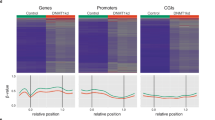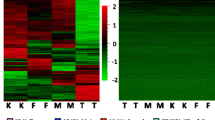Abstract
Bloom's syndrome (BS) is an autosomal recessive disorder, characterized by a high incidence of cancer at a young age. Cytogenetically, BS cells exhibit a high frequency of chromosomal damage and sister chromatid exchange (SCE). Thus, BS provides a human model of a genetic disorder exhibiting both chromosomal instability and a high incidence of cancer. In addition to its involvement in gene regulation, CpG methylation has recently been suggested to play an important role in the evolution and stability of chromosome structure. We have examined DNA methylation profiles of total DNA and some selected repeated sequences in normal and BS cells. No specific DNA hypomethylation in either total blood or lymphoblastoid cell lines from BS patients has been detected, suggesting that the genomic instability observed in BS is not directly related to a major DNA demethylation of the total CCGG sites, or of Alu or chromosome 1 satellite 2 repeated sequences.
Similar content being viewed by others
References
Cedar H, Solage A, Glaser G, Razin A (1979) Direct detection of methylated cytosine in DNA by use ot the restriction enzyme MspI. Nucleic Acids Res 6:2125–2132
Chaganti RSK, Schonberg S, German J (1974) A manyfold increase in sister chromatid exchanges in Bloom's syndrome lymphocytes. Proc Natl Acad Sci USA 71:4508–4512
Engler P, Haasch D, Pinfert CA, Doglio L, Glymour M, Brinster R, Storb U (1991) A strain-specific modifier on mouse chromosome 4 controls the methylation of independent transgene loci. Cell 65:939–947
German J (1974) Bloom's syndrome II. The prototype of human genetic disorders predisposing to chromosome instability and cancer. In: German J (ed) Chromosomes and cancer. Wiley, New York, pp 601–617
German J, Takebe H (1989) Bloom's syndrome. XIV. The disorder in Japan. Clin Genet 35:93–110
Gruenbaum Y, Stein R, Cedar H, Razin A (1981) Methylation of CpG sequences in eukaryotic DNA. FEBS Lett 124:67–71
Jeanpierre M, Turleau C, Aurias A, Prieur M, Ledeist F, Fischer A, Viegas-Pequignot E (1993) An enbryonic-like methylation pattern of classical satellite DNA is observed in ICF syndrome. Hum Mol Genet 2:731–735
Kricker MC, Drake JW, Radman M. (1992) Dublication-targeted DNA methylation and mutagenesis in the evolution of eukaryotic chromosomes. Proc Natl Acad Sci USA 89:1075–1079
Nicotera TM (1991) Molecular and biochemical aspects of Bloom's syndrome. Cancer Genet Cytogenet 53:1–13
Nicotera TM, Christopher R, Beehler B (1990) Lack of 5-methylcytosine in Bloom's syndrome lymphoblasts correlates with oxidative stress (abstract). Am Assoc Cancer Res 31:147
Nicotera TM, Notaro J, Notaro S, Schumer J, Sandberg AA (1989) Elevated superoxide dismutase in Bloom's syndrome: a genetic condition of oxidative stress. Cancer Res 49:5239–5243
Passarge E (1991) Bloom's syndrome: the German experience. Ann Genet (Paris) 34:179–197
Razin A, Cedar H (1991) DNA methylation and gene expression. Microbiol Rev 55:451–458
Sambrook J, Fritsch EF, Maniatis T (1989) Molecular cloning: a laborarory manual, 2nd edn. Cold Spring Harbor Laboratory, Cold Spring Harbor, NY
Schmid CW (1991) Human Alu subfamilies and their methylation revealed by blot hybridization. Nucleic Acids Res 19:5613–5617
Shen P, Huang HV (1989) Effects of base pair mismatches on recombination via the Rec BCD pathway. Mol Gen Genet 218:358–360
Shmookler Reis RJ, Goldstein S (1982) Variability of DNA methylation patterns during serial passage of human diploid fibroblasts. Proc Natl Acad Sci USA 79:3949–3953
Sirover MA, Volberg TM, Seal G (1990) DNA repair and the molecular mechanisms of Bloom's syndrome. Oncogenesis 1:19–32
Therman E, Kuhn EM (1981) Mitotic crossing-over and segregation in man. Hum Genet 59:93–100
Vijayalaxmi EHJ, Ray JH, Rary JM (1983) Bloom'syndrome: evidence for an increased mutation frequency in vivo. Nature 20:851–853
Waldman AS. Liskay RM (1987) Differential effects of base-pair mismatch on intrachromosomal versus extrachrornosomal recombination in mouse cells. Proc Natl Acad Sci USA 84:5340–5344
Warren ST, Schultz RA, Chang Ch-CH, Wade MH, Trosko JE (1981) Elevated spontaneous mutation rate in Bloom's syndrome fibroblats. Genetics 78:3133–3137
Willis AE, Weksberg R, Tomkinson S, Lindahl T (1987) Structural alterations of DNA ligase I in Bloom syndrome. Proc Natl cad Sci USA 84:8016–8020
Willis AE, Lindahl T (1987) DNA ligase I deficiency in Bloom's syndrome. Nature 325:355–357
Wilson VL, Jones PA (1983) DNA methylation decreases in ageing but not in immortal cells. Science 220:1055–1057
Author information
Authors and Affiliations
Rights and permissions
About this article
Cite this article
Noguiez, P., Jaulin, C., Praz, F. et al. No relationship between genetic instability in Bloom's syndrome and DNA hypomethylation of some major repetitive sequences. Hum Genet 92, 57–60 (1993). https://doi.org/10.1007/BF00216145
Received:
Revised:
Issue Date:
DOI: https://doi.org/10.1007/BF00216145




